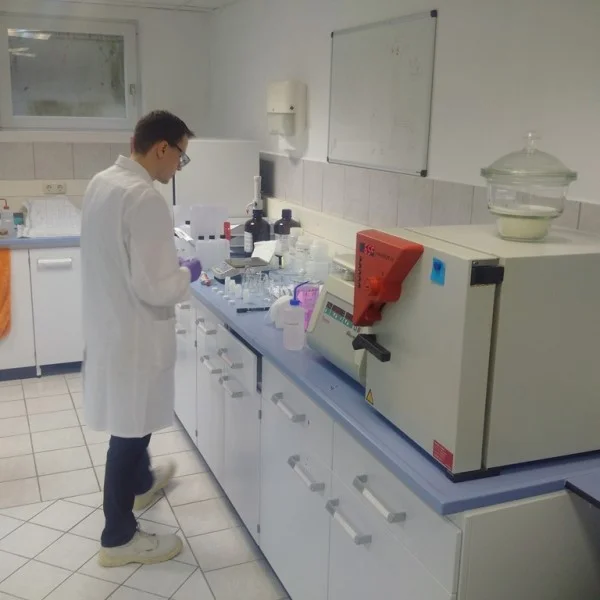 Radionuclide laboratory services
Radionuclide laboratory services
IAF determine a broad spectrum of nuclides including special nuclides
In our ISO 17025:2018 accredited laboratory we determine radionuclides in nearly all matrices, including the following:
- Biogenic carbon in secondary feed materials, bio-plastics, bio-fuels etc. - EN15440 (solid fuels), ISO 16640 (bio-based products), EN 13833 (CO2 emissions from biomass).
- Determination of the activity index of building materials (Annex VIII of the EU Basic Safety Standards 2013/59/Euratom, DIN CEN/TS 17216, DIN SPEC 18208, and other national and international regulations) and in raw materials and aggregates.
- Naturally occurring radionuclides in raw materials, products and residues (NORM) using gamma and alpha spectrometry.
- Radioactivity in drinking water, mineral water, food, beverages, pharmaceuticals and cosmetics.
- Determination of tritium (H-3) by liquid scintillation counting (LSC) according to ISO 9698, including electrolytic concentration for lower detection limits (0,2 TU) for hydrogeological research.
- Direct determination of radon (Rn-222) using gamma spectrometry - ISO 13164-2.
- Determination of gross alpha and beta activity using low level counting or LSC - ISO 10704, ISO 11704.
- Faeces and bio-samples.
- Analytical work for nuclear decomissioning, and environmental monitoring of nuclear installations.
- Agricultural, vegetable and animal products.
- Mineral, animal and vegetable oils, oily liquids.
- Production effluents, produced water from oil & gas production and geothermal energy, high-salinity water.
- Forensic analytics, e.g., for the identification of contamination sources, proof of product origin.

The table shows some of the nuclides most frequently determined in our laboratory.
| Uranium (U-238, U-234, U-235, ...) | Cobalt (Co-60) |
| Thorium (Th-232, Th-230, Th-228, ...) | Niobium (Nb-93m, 94) |
| Radium (Ra-226, Ra-228, Ra-224, ...) | Ruthenium (Ru-103, Ru-106) |
| Radon (Rn-222, Rn-220, ...) | Cerium (Ce-141, Ce-144) |
| Lead (Pb-210), Polonium (Po-210) | Cesium (Cs-137, Cs-134, ...) |
| Actinium, Protactinium (z. B. Ac-227, Pa-231) | Technetium (Tc-99, Tc-99m) |
| Potassium (K-40) | Iodine (I-131, I-129, ...) |
| Tritium (H-3), Kohlenstoff (C-14) | Strontium (Sr-89, Sr-90) |
| Phosphorus (P-32) | Antimon (Sb-125, Sb-126, ...) |
| Sulfur (S-35) | Americium (z.B. Am-241) |
| Chlorine (Cl-36) | Plutonium (Pu-238, Pu-239, Pu-240, Pu-241) |
| Calcium (Ca-41) | Europium (Eu-152, Eu-154, Eu-155) |
| Iron (Fe-55) | Neptunium (Np-237) |
| Nickel (Ni-59, Ni-63) | Curium (Cm-242, Cm-243, Cm-244) |
Our flexible accreditation allows us to develop and use new methods for other nuclides. Please contact us for further information.
Limits of determination / detection (LoD), measuring uncertainties as well as the required sample quantities and sampling methods depend on many factors. Please contact us with your specific requirements – we will be happy to help and advise.
Adequate sample preparation and radiochemical separation are crucial for the success of the analysis. The radionuclide to be examined must be separated from the matrix material and other interfering radionuclides, and brought into a specimen suitable for the counting device used. Chemical separation yields are usually determined by using internal standards (radiotracers of the same, or chemically similar, isotope).
Our laboratory prides itself with customer-oriented, flexible sample logistics, very short sample processing times and comprehensive customer support that goes far beyond mere analysis: it includes a scientific and practical interpretation of the test results, in order to help our clients understand and interpret the results. To make our clients’ life easier, we accept samples at (almost) any time of day or night and organise sample processing in such a way that the turnaround time of priority samples is minimized.
The symbiosis of consulting and radiochemical laboratory services as well as our extensive capabilities for field work (sampling, clearance measurement, in-situ-gamma spectrometry and on-site support of radiologically relevant work by highly qualified staff) enable us to quickly develop customer-oriented one-stop shop solutions.
If, in addition to radionuclides, our customers request chemical parameters to be analysed (e.g., mercury in samples from oil/gas production, landfill declaration analyses, heavy metals and other parameters), we work closely with laboratories that are accredited for these substances in accordance with ISO 17025.
IAF have developed and perfected a number of standard measuring methods, for example, direct determination of Ra-226 by gamma spectrometry or the gamma spectrometric determination of Pb-210.
IAF has fully implemented the requirements of ISO 11929 (Determination of the characteristic limits, decision threshold, detection limit and limits of the confidence interval for measurements of ionizing radiation).

Example: Why and how do we determine biogenic carbon (C-14)?
Biogenic carbon is usually expressed as a proportion of total carbon. This is important for companies that participate in emissions trading and have to prove what proportion of their fuel consists of renewable raw materials. Various standards apply, e.g. DIN EN ISO 21644 - formerly DIN EN ISO 15440, or ASTM 6866. Alternatively, the content of biogenic carbon in the off-gas can be determined, according to DIN EN ISO 13833, because the ratio between "normal" carbon and C-14 in the fuel remains unchanged during combustion. Manufacturers who advertise their products as "sustainable" or "organically produced", e.g. glue, paint, coatings, etc., also need proof that the carbon content is not fossil, but from renewable sources. In this case, relevant standards are DIN EN 16640 and EN 16785-1.
The C-14 method requires particularly careful sample preparation, but is incorruptible because it directly measures the weak radiation that occurs during the decay of C-14 nuclei. At IAF we have various methods of C-14 determination. We often use controlled oxidation to convert the samples into carbon dioxide, which is first passed through an adsorber and concentrated there. It is then desorbed and the proportion of C-14 is measured with high precision using liquid scintillation. In addition, depending on the sample matrix and requirements, there are other methods that we would be happy to discuss with you personally.













 Radionuclide laboratory services
Radionuclide laboratory services